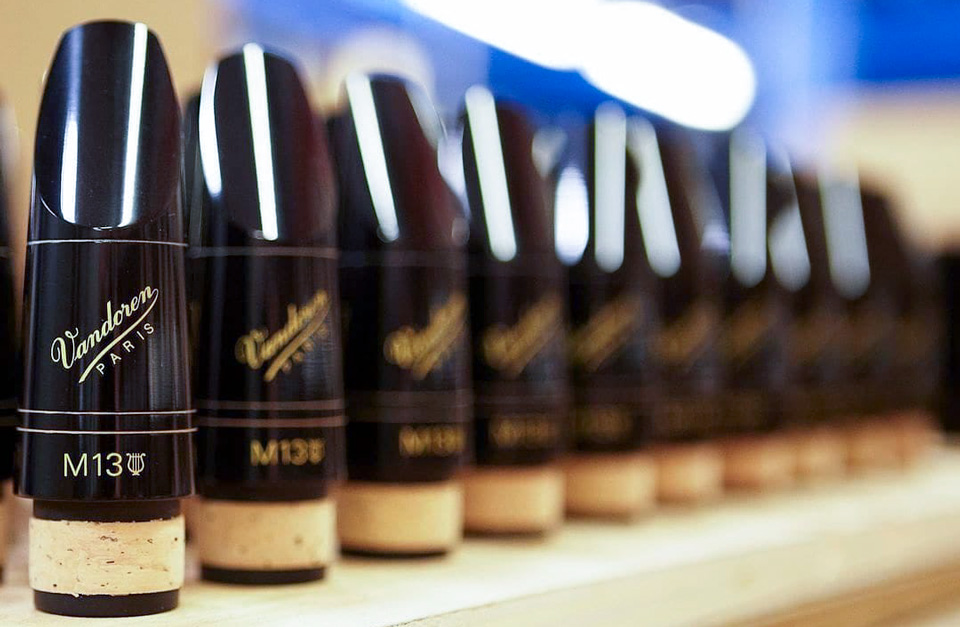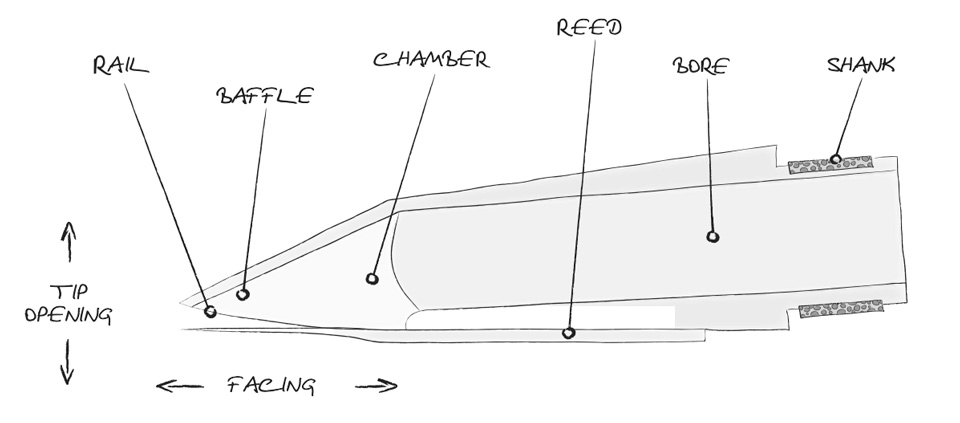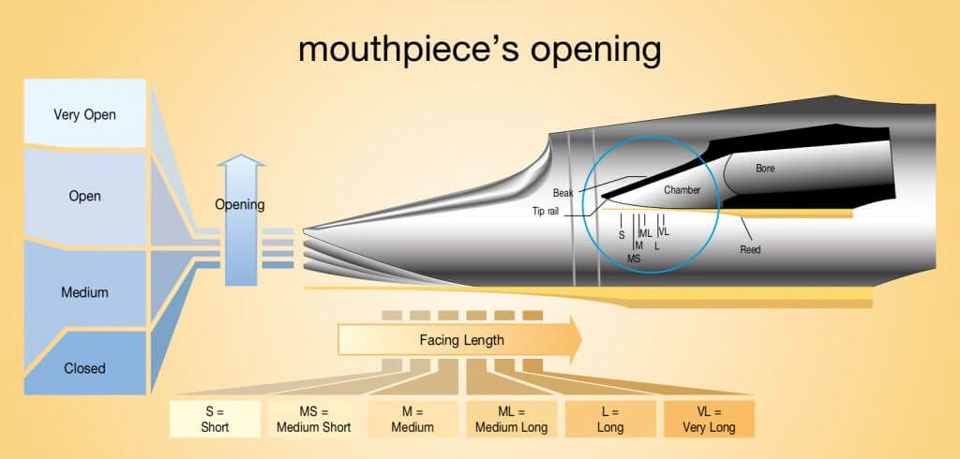Ultimate Guide – Clarinet Mouthpieces
4th July 2022Students, intermediate players, hobbyists and professionals…clarinettists of all levels inevitably go through the process of finding a new mouthpiece. Clarinet mouthpieces appear simple, but their intricate designs ensure no two are the same! This ultimate guide will explore all things clarinet mouthpiece to help you make the best choice next time you purchase.

Why is clarinet mouthpiece choice important?
Your mouthpiece is the first point of contact for your airflow. It’s the anchor point between you and the instrument. The internal design of the mouthpiece will be a major factor affecting the tone and response of your clarinet. If you know what sound you’re aiming for, then you can make an informed choice based on design.
Beginner mouthpieces are designed for an easy play, but don’t always have the most sophisticated tone. A few years in to learning, a teacher may recommend upgrading the mouthpiece to help develop the sound. Generally, you’ll move from a mouthpiece made of plastic to one made of hard rubber, also known as ebonite. A new mouthpiece will help students further develop their sense of tone, dynamics and articulation.
How do clarinet mouthpieces differ?
Most mouthpieces on the market are made of ebonite, but some – mostly student mouthpieces – are made of plastic. Plastic is the material of choice for student models such as this Windcraft beginner model. Plastic is more affordable to produce, and therefore more accessible to beginners. Ebonite has been a popular material for mouthpieces for over a century, due to it being hardwearing, offer a rich tone, but easy to manufacturer consistently.
The main differences between mouthpieces come from the design of the tip opening, rails, baffle and chamber. Every mouthpiece varies from one another in one or more of these features, with each one affecting elements of response. Narrower tip opening with wider rails? Expect to play with greater resistance. High baffle but an open chamber? Then it should have a bright, broad tone!

What are the main clarinet mouthpiece design features?
Each mouthpiece has a flat table – the flat side of the reed is placed here and secured with the ligature. Every other part of the mouthpiece, however, is different! Even the slightest differences in dimensions, down to 100ths of a millimetre, yield a variety of results.
- Tip Opening and Facing
- Tip opening is the distance between the tip of the reed and the tip of the mouthpiece.
- A more open tip usually contributes to a more free-blowing response.
- It can also give the mouthpiece a more ‘open’ tone.
- Mouthpieces with a closed tip are generally more resistant.
- High resistance often translates to a ‘direct’ tone.
- The facing refers to how long the curve from the table to the tip is.
- Rails
- The width of the rails, which support the outer edges of the reed, affect response too.
- Wider rails will contribute to resistance, narrower rails will be more free-blowing.
- Baffle
- This is the curve – or lack thereof! – running inside the mouthpiece from the tip into the chamber.
- Higher baffles push the airstream through the mouthpiece quicker and contribute to brighter tones with greater projection.
- Chamber
- Just as it sounds, this is literally the ‘chamber’ inside the mouthpiece.
- The size and shape of the chamber has an affect on tone, projection and response.
- More closed, rounder chambers create focused, literally ’rounder’ tones.
- A more open chamber can help the sound really ‘spread’.

Which designs suit which players and styles?
As much as certain mouthpieces can ‘suit’ certain uses, there are no set rules. A clarinettist should find the mouthpiece they think works best for how they play. If that means you find a typically classical mouthpiece is best for your jazz playing … then go for the classical mouthpiece!
Classical players are typically drawn to a clarinet mouthpiece that can produce a dark, rounded, focussed tone. A great scope for dynamics, from a soft pianissimo to strong fortissimo, is always appreciated! Mouthpieces that are more closed at the tip, with a low baffle and slightly broad chamber would give the player a good mix of resistance with mellower tones.
For jazz, players usually look for a mouthpiece that will sing over the rest of the ensemble – bright and lively, with effortless projection. They will therefore lean towards mouthpieces that prioritise a more open tip and higher baffle, as this combination allows for a brighter tone and can accommodate a strong airstream.
There are players of course who appreciate a good ‘all rounder’. Students studying multiple genres, hobby players attending different ensembles, musical theatre specialists who need a mouthpiece that can speak in all styles … of course, the ‘in between’ clarinet mouthpieces can be winners too!
Some popular choices…
Those seeking a focussed, mellow tone for classical styles often pick the likes of the Vandoren 5RV and M30, Selmer Focus, Concept and the new Echo, and the Backun Vocalise R and G. All of these lend themselves well to a darker tone when paired with harder reeds.
Jazz players, and others who may be looking for a brighter, freer tone have a number of options also. From Vandoren they may consider the 5JB or 7JB, or the Vocalise Z. Saxophone mouthpiece makers Otto Link and Meyer also produce options for clarinettists. These are especially well suited to jazzers looking for a more traditionally ‘smokey’ sound. The Meyer has a brighter character than the Link.
If the extremes are too much either way, or you’re one of these players who love an ‘all rounder’, then the following options would be worth considering. The Vandoren B45 is labelled as their ‘universal’ mouthpiece, popular with students to pros across all genres. The Vandoren Black Diamond BD5 has also proven itself to be an incredibly popular choice for all sorts of players. The Backun Vocalise H opening is also a great middle ground.
How do I test clarinet mouthpieces?
We chatted to UK pro-player Alastair Penman to get his advice on how to test clarinet mouthpieces (above). You can read further here, but the five major points to consider are;
- Try the mouthpiece on your own instrument.
- Compare it against your own clarinet mouthpiece.
- Try it with an ‘appropriate’ reed.
- Test the tuning across the range.
- Try in an environment you know.
If you think it may be time to switch mouthpieces or want to explore the options we have to offer, book an appointment to test a selection in one of our dedicated testing rooms. Our team of specialists are on hand to guide you – even if you’re not sure which might be best for you, we can help you find a few options to explore and find your sound! If in doubt contact us for help and advice.